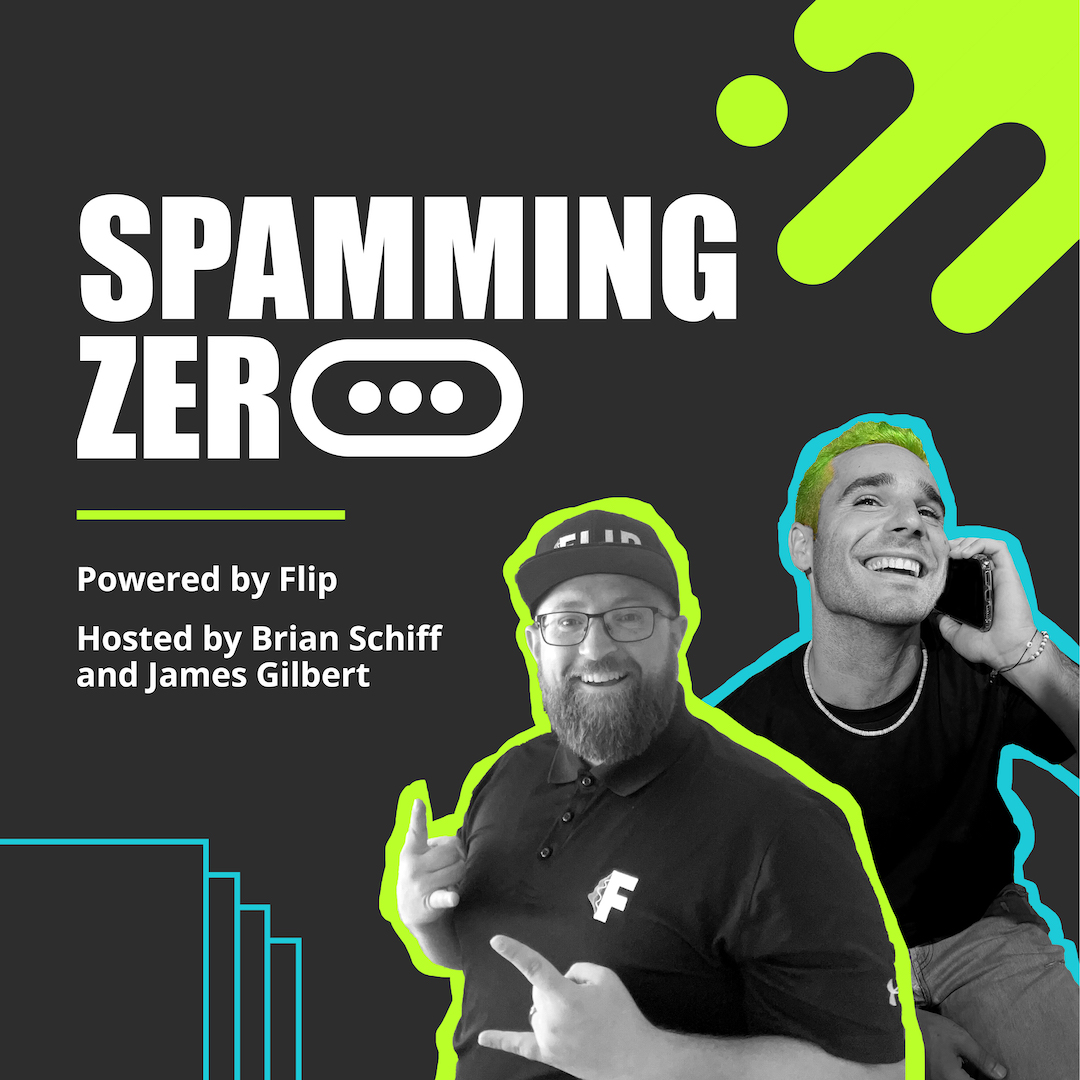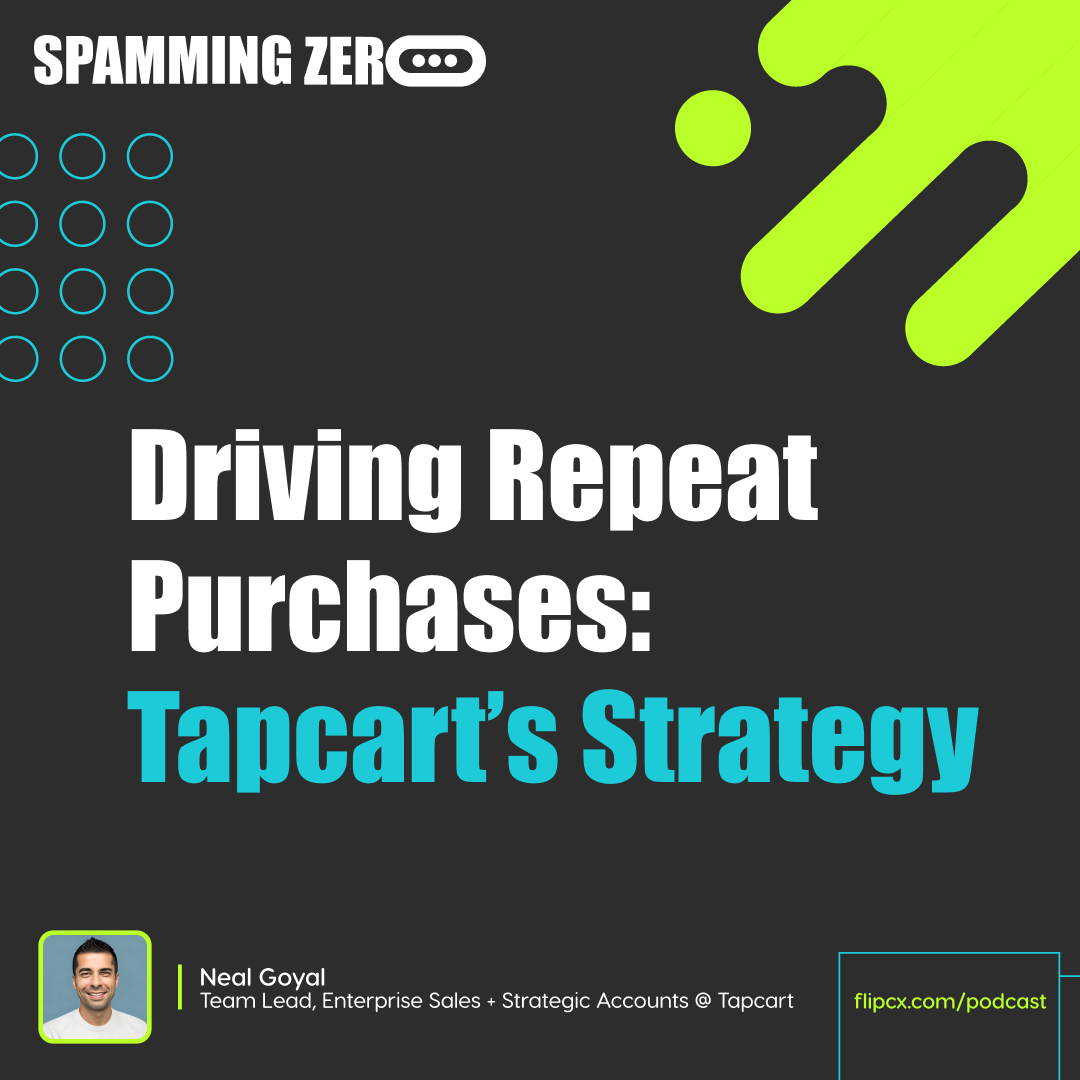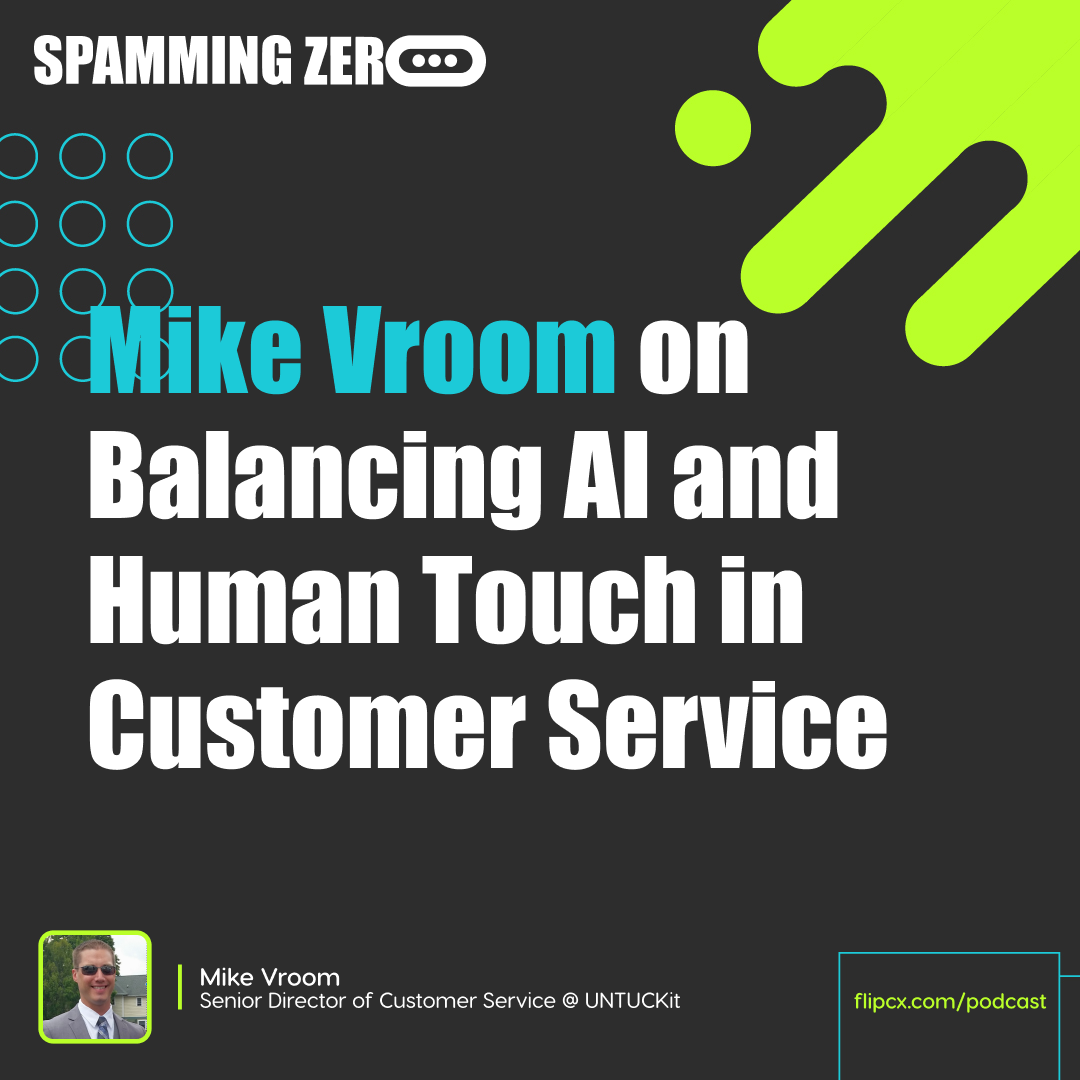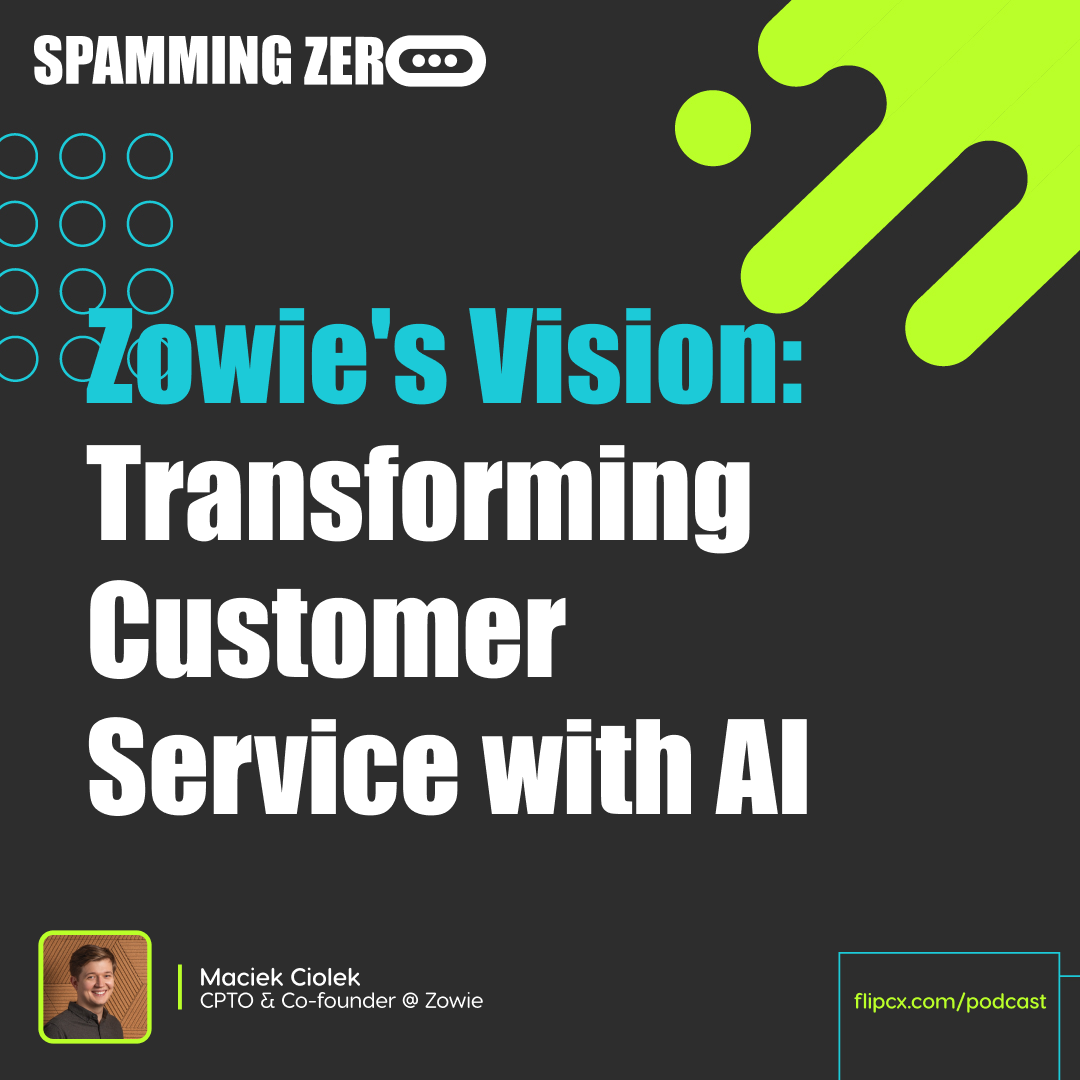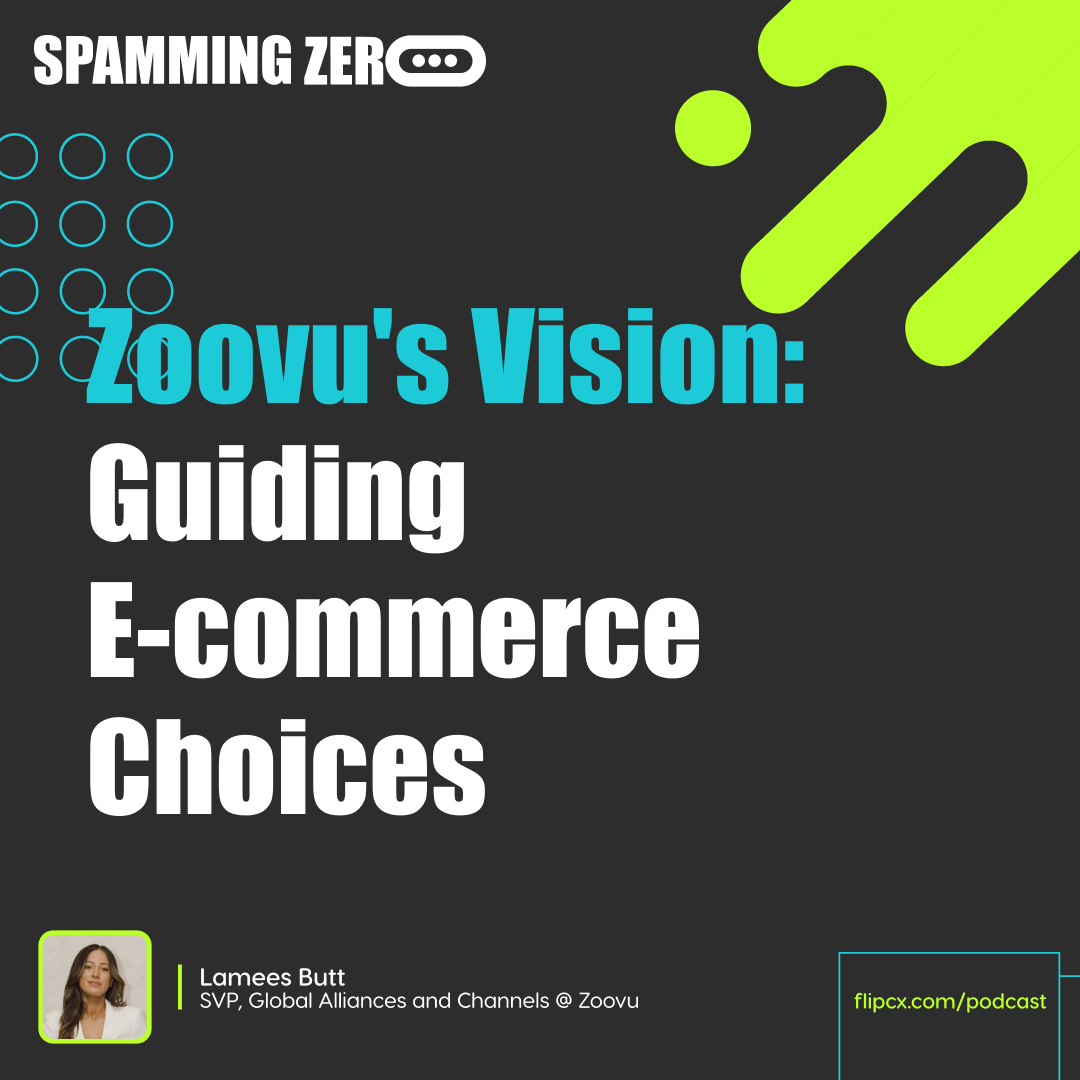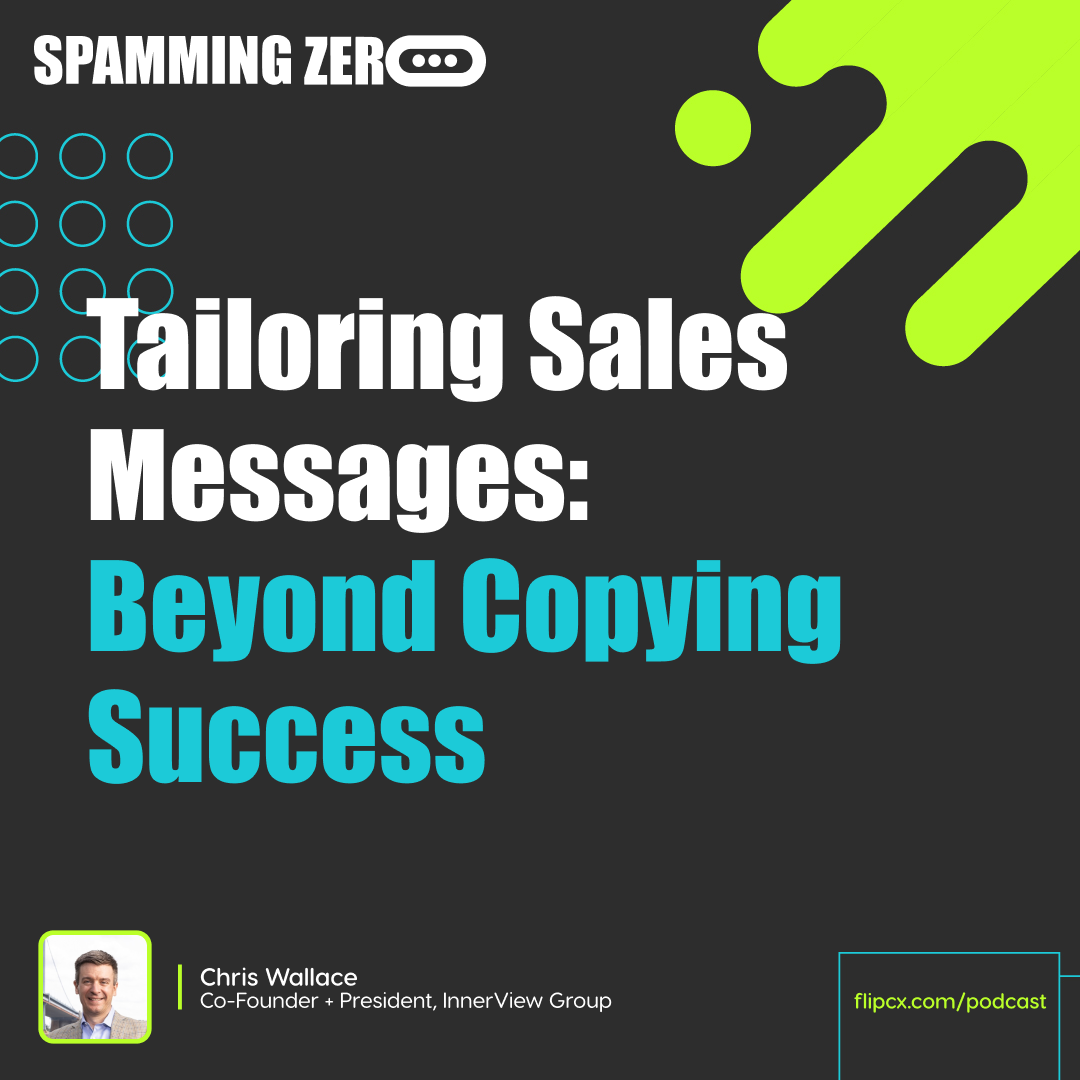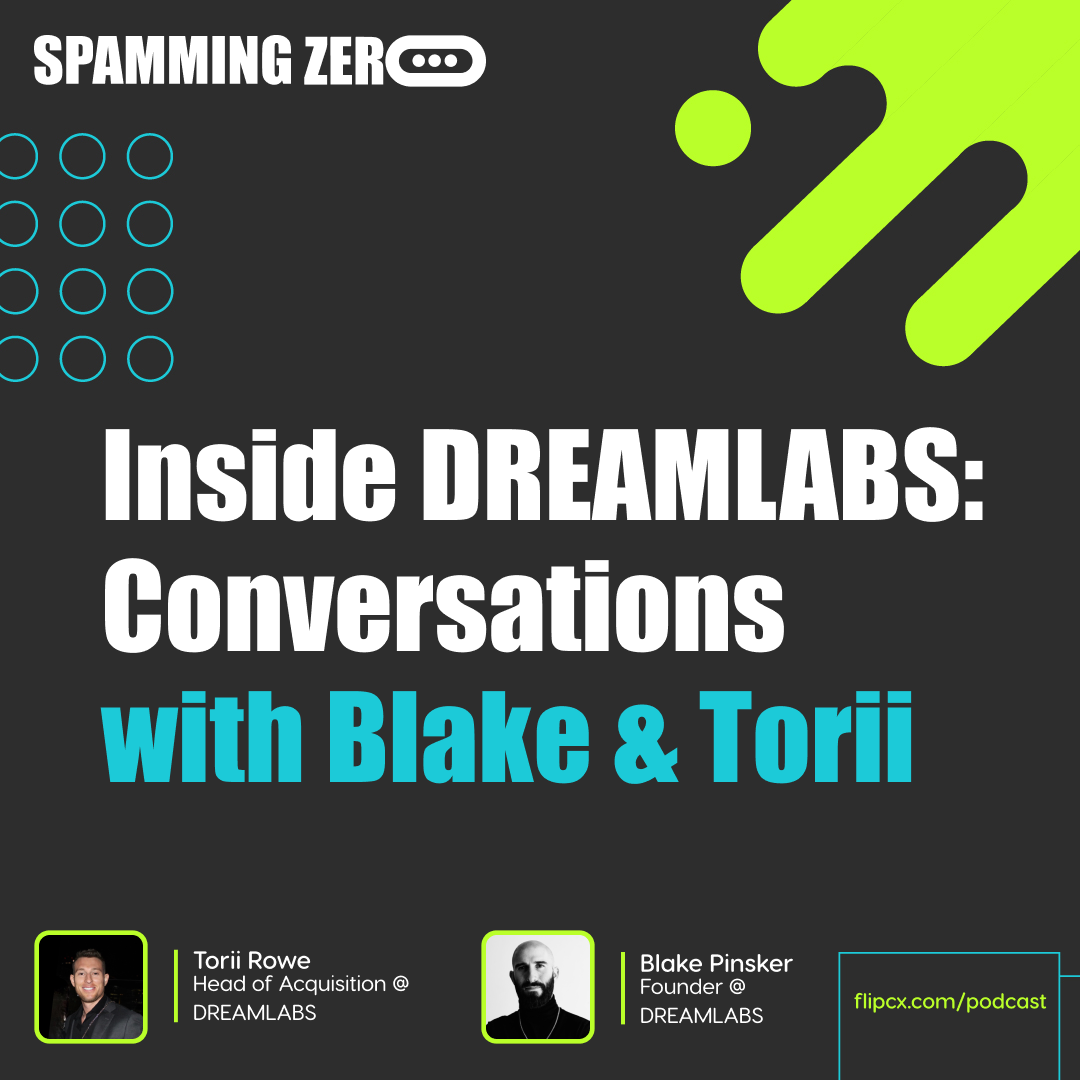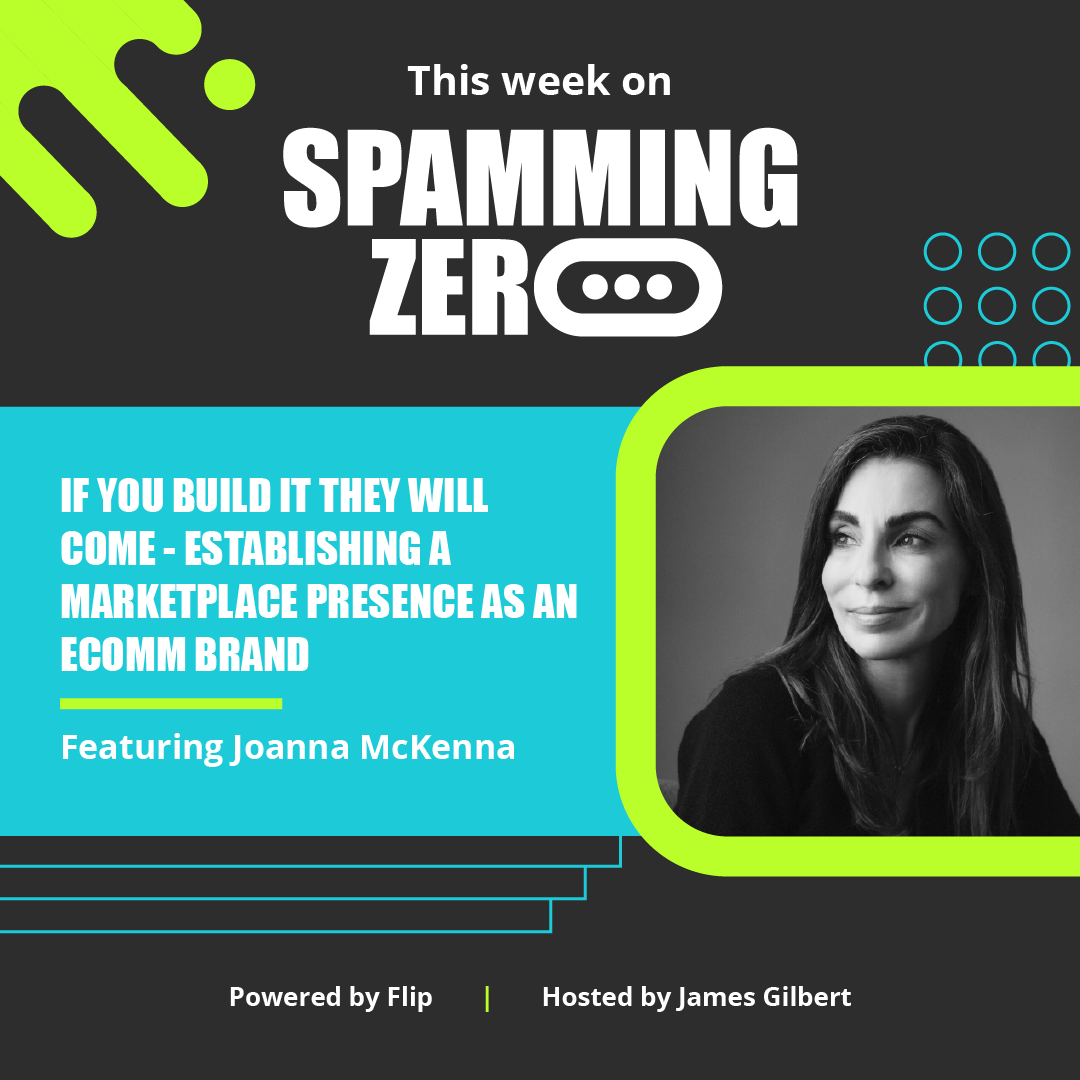Episode 62: Driving Repeat Purchases - Tapcart's Strategy, With Neal Goyal
- 0.5
- 1
- 1.25
- 1.5
- 1.75
- 2
Neal Goyal: So, what would I kill? The mentality that tech is going to solve your problem. Tech is meant to be an amplifier, it's meant to be an accelerator, but it's not going to solve core problems that are solved by understanding Business 101.
James: I'm James.
Brian: And I'm Brian.
James: And this is Spamming Zero. August 2023, this month's sponsor of the Spamming Zero Podcast is Richpanel. Richpanel. com, go check them out. They do self- service automation at scale for eCommerce brands and direct- to- consumer brands. Some of their self- service models are order management, returns and exchanges. They have a branded help center as well, agent handoff, custom workflows, and very soon, subscriptions. We love Richpanel, they're one of our partners as well. Here are some of their customers that use them: Thinx, another one is Snow, if you're familiar with Snow, Brute Force, the Puppy Dogs Ice Cream Company, lots of companies directly in the direct- to- consumer world. Also, they have a bunch of different resources for their customer testimonials. Some of the integrations that they do directly on their website, love some of the stuff that they do. They also have a pretty wide range of partners that they work with, so if you're currently having a partner that has something in their stack and you're wondering if they integrate with it, they have a lot of that. But one of the biggest things that we get all the time is some of the order management. So, the self- service options let customer manage their orders. Customers don't need to raise a ticket to make edits to their Amazon order, change the shipping address, or they forget their coupon code. Give your customers the same experience on your website, that's what Richpanel does, self- service automation, richpanel. com. What's up, everybody? It's a Monday and we have another show of Spamming Zero on the cusp. We are joined today by Neal Goyal from Tapcart. Neal currently is the enterprise lead at Tapcart, and if you don't know what Tapcart does, love their vision. I actually pulled this directly from Neal's LinkedIn, which you'll see if you go visit him. But this is what they do, they help brands on Shopify Plus solve challenges with conversions, retention, CX, customer acquisition, and engagement. Now, Neal, welcome to the show.
Neal Goyal: Hey, thanks so much, James, for having me. Glad to be here. Love what you guys are doing and just a pleasure to be here, thank you.
James: Yeah. So, tell me a little bit about this because if I look at those things, all of those things can be very, very broad. So, narrow the scope a little bit for all the listeners. How do you help eCommerce brands?
Neal Goyal: Yeah. Well, when you think about when I typically have a conversation with a brand and what I do here, the goal is to help a brand with their retention strategy. Ultimately, we know that brands are doing a number of things at the top of the funnel to drive traffic their way. The question is can they bring that customer back? Can they continue to drive those repeat purchases and engagement? And so, that's what our goal to learn here when I'm having a conversation with them is how can we create systems and put processes in place to drive that engagement higher? Now, when you think of the concept of retention, it's not a single- faceted approach. In fact, you have to look at it from all different lenses and we become a trusted advisor in the process of consulting these brands. And so, when you think about the core pillar of retention, you think about, well, what good is any retention marketing tool or message if your product or customer experience isn't absolutely top- notch? That is the absolute foundation for retention is having a killer product and amazing CX. From there, you can introduce new tools and systems that help nurture frequent purchases. Some brands will leverage loyalty programs or subscription programs to facilitate that. And then when you think of the actual customer experience side of things, when you think of the aspect of retention marketing or messaging to your existing audiences, how do you go about doing that? And that's where we at Tapcart, we end up helping brands launch mobile apps that essentially give that mobile CX, an experience that a customer can't get anywhere else from the brand. But then in the process of doing so, leverage push notifications and other mechanisms to give customers the best possible experience in mobile that nurtures more frequent purchases. That's the endgame goal, but it comes with understanding the other foundations and strategies that they're integrating into their whole strategy.
James: Love this. And this, by the way, is not going to be the full topic that we're going to be talking about today. We're going to get into some nitty- gritty stuff with Neal, but I just want to back up some of what you're saying with some stats. So, HubSpot recently did a big customer retention report in 2023 like 51 Stats That You Need to Know About Retention. One of them I found very promising, which is this. There is 60 to 70% chance of selling to an existing customer. So, versus the other where you have to do acquisition, it's a little bit different. You have a 60 to 70% chance of selling to an existing customer versus somebody who you don't, who's net new. On top of that, if you look at customer retention in mobile apps and email marketing, for example, only about 44 to 52% of businesses are actually using a mobile app today to actually help with this. So, there's a huge market that's not using one, or there's people probably using it and they're not doing the greatest job because there's also this stat. The average eCommerce retention rate is only around 30%, which means you have a pretty big margin to improve here and there's many different ways you can think about retention, and Neal has mentioned some of them. As a CMO of a company, there's a lot of things you can think about when it comes to retention, and I think when you have people's attention, whether that's whatever channel they're on on the web, chat, email, SMS, phone. When you have their attention, these are always moments that have an impact on your retention rates. And one of the things that we've been playing around with with voice at Flip is how brands can use voice also to improve their retention rates more than ever. Because you have the attention of pp. They're actually reaching out to you proactively, and I think that this is oftentimes forgotten about when it comes to retention. So, what are your thoughts around that? When people are proactively reaching out to brands, how does that play a role into how you guys approach retention?
Neal Goyal: You're absolutely right. When you think about it, the cost to acquire a new customer is about 10x the cost to retain an existing one, per what you shared from HubSpot. And so, that's where when you think about what has happened in the last couple of years with the customer acquisition cost just continuing their parabolic meteoric rise, the question for brands is, well, when am I going to actually become profitable with this customer? And most brands are not profitable with that first purchase. They enter at the top of the funnel, customer acquisition costs are so high that that first purchase is likely not profitable. So, how do you nurture that customer into a deeper funnel that gets them to purchase more frequently? And that is the conundrum here that brands are trying to fix. And so, when you highlight that HubSpot study about 40 to 50% of companies are using a mobile app in some way to boost engagement or drive retention, you're absolutely right. However, if you dissect that even further, that HubSpot study is a much broader study. It's all types of businesses. But when you think of, for instance, brands on Shopify. When you think of direct- to- consumer brands, that number shrinks down all the way down to 5%. And so, the question is if I am a brand and I'm trying to engage my customer, and my customer as a being is programmed to do everything in our lives on an app. Check our Google Calendar on an app, communicate with our team via Slack on an app, hail a ride on an Uber via an app, order a meal via DoorDash on an app, shop on Amazon via an app. And then we point our coveted customer that's already in our funnel that we're trying to give the best possible experience to a website. And that is the big challenge there is how do we nurture that customer further down the funnel. They're much more likely to buy, but why don't they buy more frequently? If they're higher intent, why aren't they buying more frequently? And why are they still abandoning their cart at such a high rate? And a lot of these things speak to the CX side of things as well.
James: Yeah, I love that. So, a lot of people don't know how we come up with the topics around Spamming Zero. So, we're going to give you an under- the- hood look for those that are listening. Today, instead of me doing a quick question with Neal, which I'll explain, we're going to do a live on the show today. So, I ask this same question to everyone that comes on the show, and that's this. And I want you to just rant on this, Neal, okay? So, I want you to tell me something that you're passionate about that you think a lot of people would disagree with you on.
Neal Goyal: That's a great question. I think the first thing that comes to mind is when I talk to anywhere between 12-16 enterprise- level brands each week. And over the course of learning about their strategies, they'll often ask me the following question, " Hey, what can I do to boost customer purchases? Oh, I want to talk about push notifications, I want to talk about an app." And many times, I actually push back, and I say, " Wait a second, let's talk about your product. Let's talk about your customer experience first because none of this matters if product isn't given the superior focus." If customers that are already in your funnel are not having the ideal customer experience, there's no retention marketing tool that can save you. There's no email campaign that can save you, no mobile app that can save you. And when you think about when someone I'm having a conversation with, they're obviously high intent talking about a mobile app hearing that, oftentimes it can ruffle some feathers. It can make people feel uncomfortable and really second- guess what they're doing. And so, oftentimes I come prepared to these conversations. Even though we are not necessarily solving their product challenges or the customer experience challenge right out of the gate there, I come prepared with a handful of reviews and the way users are talking about their brand right now. I do an analysis of the product and what the community is saying about them right now. And the first question I ask for a brand that either maybe has consumables or whether maybe they're in the fashion apparel space or beauty space, is what does your repeat customer purchase rate look like? And that'll tell the story right there that repeat customer purchase rate can be improved with these retention marketing tools, and it can help you there, but if your repeat customer purchase rate's below 15%, you have a lot other bigger fish to fry than to have a conversation about retention marketing tools. And that does... I think brands when you think of the amount of brands on Shopify right now, we have two million brands on Shopify, and a very tiny percentage of them are actually giving the attention to product and experience that they should be. And again, sometimes that's hard to hear.
James: So, I'm curious, this opens up a world of questions that I have in my mind right now. One of them is what is the big problem that you think most of these brands have when it comes to their customers? Is there a commonality that happens with it? When you do your analysis, by the way, going in and sending them customer reviews I think is absolutely brilliant because I think that sometimes gets overlooked. Sometimes people think of that as, " Oh well, we have this handful of reviews in our social media accounts and on our Google accounts and stuff like that." This is people that were upset with one single moment and whatever, so they discount it as non- insights. This isn't validated enough because we don't hear it enough. So, one, what's your thoughts around people that have that mentality with those reviews when you present those to them? And then two, what do you think is the most common thing that people run into when they need to fix their customer experience?
Neal Goyal: 100%. So, think about the psyche of the Shopify merchant. These are the most innovative, the risk- takers, they're glass- half- full, they're scrappy, they'll find any way to get the answer that they want. Again, this all amounts to them just being glass- half- full or possibly overflowing, and that's a great thing. That's what drives successful outcomes is a very optimistic mindset. That can also work against you in the form of when you do get some kind of negative feedback, you have a tendency to justify it or explain it away or find a reason why that doesn't apply to your brand and that's an anomaly. So, this is a scenario where when you think about sales, when you think about having a conversation about any tool with a brand, I'm a huge believer in what's called the challenger methodology. In other words, instead of understanding a brand's problems and then trying to find solutions to fix those problems, have the brand learn how to think about that existing problem, but just in a different way. In other words, if they come to you saying, " Hey, we want to improve our CX," well, have them walk away thinking about CX in a different light than they have before. And I think this is one of those things that does that is pushing back and saying, " Okay, yes, I know these may be anomalies, and I know they may be discounting the impact of these reviews, but the reality is there are probably a lot of areas that need to be fixed. And if you can help them walk away understanding that a little bit deeper level, then you've done a good job, I think.
James: I love your approach too because I think that more vendors need to be doing this. I preach this all the time when it comes to eCommerce is most vendors that are in this space that are serving eCommerce, or direct- to- consumer brands, or even CPG brands, one thing is absolutely certain. Most of them solve a small piece of the big pie that eCommerce professionals are having to manage on a day- to- day basis. So, you have a whole slew of things that have an impact on the customer experience, and Tapcart, for example, and what you guys do is one piece of that. What we do at Flip is one piece of that, and what your help desk does is one piece of that. What Shopify does is one piece of that. And very rarely do we hear vendors at all in this space talk about providing value that's deeper than your product. And I think by challenging some of these brands that you're running into and saying, " Hey, hold on a second. Sure, we could solve this little piece for you right now, but let's talk about the broader picture and all the pieces of the pie that are missing right now and that we need to fix." And I love that you're doing this because I have been talking about this, especially internally at Flip all the time. But like, hey, we're one part of the picture, so how are we solving for the bigger part of the picture for them? When we have conversations with people, how are we making sure that we're going deeper than just what we can provide? And I love your follow- up answer to my question because I think it aligns perfectly with that.
Neal Goyal: Yeah, I mean I think at the end of the day vendors can take two schools of thought. Look to solve that problem right away on its surface, but then that scenario also probably increases the likelihood that that customer may end up churning out because of that. In other words, if you didn't look at the problem at a much deeper level, how likely are they going to be a long- term success candidate with your solution? Churn is the bane of any software provider's existence. So, when you think about where by understanding and pushing back and challenging these customers. Helping them understand that, hey, in our particular scenario, an app can't save you. You need to address your product challenges first. The reason why we say that is that many brands come and turn to tech to solve their quick- fix problems. And the reality is these problems just go back to Business 101. It's not any fast tech that can save you, and ultimately, when they come in thinking it can, that's a customer that's likely to churn out because they didn't solve the root business problems too. So, that's why it's a very healthy pushback and most brands receive that quite well. Initially, they might be a little bit thrown off their rocker a little bit-
James: Wait a minute, what?
Neal Goyal: Yeah, but ultimately, they walk away with it understanding this individual actually has my best interests at heart here, and he told me maybe now is not the right time to start something like this, but I'm 100% going to have a conversation with him in four months because of that. And I think that's the long game approach I think is where most software vendors when they're really trying to align for success, that's where they come out ahead.
James: Yeah, I love that. I always get a little bit nervous about sharing stats and let me explain why. See, I'm a numbers guy and one of the things that drives me nuts about some of the statistics that are thrown out in some of these studies is they really are quite biased in a lot of ways. They only poll the exact same people or exact same industries and businesses, and so you're going to continue to get the same responses over and over. And I don't think there's enough... Even some of the biggest research companies in the world I just don't think do this without bias. But I do want to point out one thing really quick because I want to dive into the topic of loyalty, for example. So, worldwide, companies spend about 75 billion per year on loyalty management systems, which that's huge. And there's quite a few brands that we work with that have loyalty programs as well. But this is a big part of retention, especially when it comes to eCommerce, so there's a lot of brands out there that have specific loyalty systems and processes that they leverage. So, what do you think is the big positive about having a loyalty management system? And then what are some things that people should be thinking about if they want to start one?
Neal Goyal: That's a great question. So, when you think of the major loyalty providers out there, at least in the Shopify ecosystem where we work, you think of Yotpo, you think of Smile, you think of LoyaltyLion. And so, again, I get asked this question a lot. When you think of apps, it's a loyalty driver in and of itself, but I get questions about these loyalty platforms as well. And while we're partners with all of them, we integrate with all of them, the reality is that most brands are still looking at a loyalty program as a quick fix for retention when the reality is you need to understand that loyalty program when used effectively, when given the right amount of attention can be a huge revenue unlock. And let me explain what I mean by that. I'd say nine out of 10 brands who are using a loyalty program are just going after the traditional, " Hey, accumulate your points and get discounts and redemptions on the back end." If you take that overly simplistic approach, you're going to find that you are introducing your most valuable customers into a funnel that is going to extract less and less profit from that customer over time. And brands that suffer from that are the ones that just turn on the switch to a loyalty program without really giving a whole lot of thought thinking it's a quick fix to shaping customer behavior or repeat buying behavior. When the reality is if retained customers are going to be your most profitable ones, why are you chipping away at that margin over time? That's the margin that's going to save you at the top of the funnel. And so, I think loyalty programs are great, I think membership programs are great. But at the same time, just like with any piece of tech or tool that you're looking to integrate, it's the way you go about integrating it. And that's where brands struggle. If you think of the amount of success that some of these brands on Shopify Plus have had, they've been built on the backs of three humans. I mean these are hyper lean teams. You see some of these big, big mega brands and you think they have these huge teams. No, it's three humans on that marketing effort, which means they're totally strapped for time, they're spread thin, they're wearing many hats. And so, when they integrate all these tools, they're only using 10% of what it could be thinking it could be a quick fix. So, I would say loyalty programs can work when used effectively when you put a lot of thought, and strategy, and curation into how that CX plays out as you continue to bring that customer further into the funnel.
James: When you think of the best loyalty programs that you've run into, and I know I'm putting you on the spot here, so I'll give you a bit to think about it if you need to. But what are some brands that come to mind that are doing loyalty really, really well in regards to what you just mentioned?
Neal Goyal: Yeah, so one example I can give is a lot of drop- based brands. Brands that have had a lot of success at the top of the funnel driving excitement towards new releases, new product releases, color releases, flavor releases. Whatever category that they're in, if they can drive excitement towards those drops, they're leveraging loyalty programs to give exclusive access to those users once they accumulate a certain number of points. Right, so think about this. Now you say, " Hey..." Normally, you would drop it on the website. Okay, now, what if you decided to let's say launch an app and say, " Hey, download our app and be part of this community where you can have access to these exclusive apps six hours early, or three hours early, or a day early, or something like that"? But with our loyalty program, if you've purchased X amount over the course of time, you're going to get even earlier access than those. So, create different tiers of access. I think the most successful Shopify brands have a high repeat purchase rate and have a lot of reception to these drop- based strategies. And this is a scenario where loyalty programs can really help fuel it instead of diminish margins over time.
James: I love this so much. I'm a big believer in... Here's the thing, everybody loves a VIP experience. You could tell somebody, " Hey, we're going to..." If you had two groups of people and you presented the exact same idea to them and all you did was say to one group of people, " This is a VIP experience," versus the other group of people and you don't say VIP experience, guess what? The people that think it's a VIP experience are always going to be more engaged and proactive about their approach, and the consumption of that. So, I love the fact you're bringing this up because this is something that I've been screaming from the rooftops as well, and that's this idea of... Especially, I think about apparel brands, actually, or even luxury brands. I mean you think about the unlock here. You have loyal customers, you can track that, and imagine instead of them getting the normal, " Oh, I can earn my points and I can cash that in." Instead, they're getting exclusive messages that are saying, " Hey, guess what? We have this new product line that we've never released to the public, and because you're a VIP loyal customer, part of our program is we're going to let you have first dibs at it." And I think about one brand, which I bring up actually a lot on this podcast, but I really like their model and that's Aviator Nation. They're one of our customers at Flip, and maybe that's why I like them, but also-
Neal Goyal: One of ours as well. One of ours as well.
James: What they do is so incredible. They don't produce this crazy amount of their products at a time. You could call it the scarcity tactic. Where something is scarce, it's high in demand, and they do this incredibly well. And I think they could probably do it even better. They might actually be doing this, I've never asked the folks at Aviator Nation. Maybe you might know, but I think about them in this particular way because they have these scarcity products. So, if they're only releasing a certain amount to the public, which if you've ever watched their social media accounts, people just go wild, or their stuff... They're like, " Oh my gosh, when is the next line going to come out?" I follow the CEO really, really well because she's just incredible and does this incredible design stuff and does it in public. So, people are genuinely engaged with their brand, and what I love that they do is the scarcity tactic plays a huge role into this. And if they present this to their loyal customers and their fanbase and they say, " Look, we only have a thousand of these shirts that we're going to release to the public, and our most loyal customers that have been with us for a long time get first dibs on it." I mean it's just like it's the perfect unlock for so many brands. Well, Aviator Nation's just one example, but I think apparel brands, especially the exclusivity factor of scarcity or even really, really strong fanbase, I think it's a perfect tactic people could use.
Neal Goyal: You're absolutely right. I mean Aviator Nation has been a wildly successful customer of ours for this exact reason that you're highlighting. They have certain level of scarcity with each collection launch or design launch that they have, and exactly what they do with their mobile app is say, " Download our app to be a part of this exclusive community that can have early access to these collection launches." So, if you download the Aviator Nation app, opt into those notifications, your notice, you're going to get a push notification with this new design that just went live and it's not available on the website yet. And this is a way for you to say, " Hey, how do I make my app user or someone that's in the lower part of my funnel feel that much more valued than the average Joe Schmoe that's just arriving at my website where they may or may not buy. So, you're speaking to exactly that. This is the reason why Aviator Nation has driven tens of millions of dollars of revenue through their app alone is the vast majority of that is coming from two areas. Number one, early access to these products and collections, and number two, certain collections being available at different prices in the app versus the website as well. So, when they are selling out, they're able to control that in both environments and that gets people excited.
James: It does. I became a big fan of Aviator Nation when my daughter was scrolling around, and she was showing me stuff that they have. I ended up ordering a bunch of stuff from them, but I'm on a weight loss journey and none of their stuff fits me. I saw their new product line when it came out with their CEO. Literally, they did this big video, and she was in this warehouse, and she had all these clothes hung up, and had these... I don't know if it was paint or what it was, but she was just splashing paint all over.
Neal Goyal: Yes, yes.
James: It was wild and amazing, but man, did that go viral. So, many people were like, " How can I get access to this product line?" And I just think it is a beautiful, beautiful example of how you can do this at scale. And by the way, they're still one of the fastest growing eCommerce brands out there, and with no funding, which I think is just crazy amazing.
Neal Goyal: It's an incredible story. It's a concept of what it means to build community too that's equally a part of building brand engagement, fueling repeat purchases, but more importantly is getting people having conversations about the brand. Just like the conversation you had with your daughter right there. Mastering community is something that every brand wants yet very few can do, and I think that's something that Paige and her team has definitely absolutely crushed that game largely because of her constantly building her brand in public. Everyone is seeing her journey go from nothing to on the Forbes list for most successful women in America. It's an incredible story and a large part of that has to do with what they've done in terms of building that community, which cannot come from a loyalty program, cannot come from an app, cannot come... All of those things help it. What ultimately is going to be the driver of that is just your ability to drive conversations about the brand and have them talking about you more than they are others.
James: I love that. We had Matt Solusod on the podcast from Aviator Nation. He runs their customer service department, and I think I'm going to send this clip to Paige because I think our listeners would love to have Paige on the show. And maybe we could get Paige to come on and talk about the journey a little bit and some of the failures that happened as well. Because that's also a big part of it, right? We learn from those things. So, we've talked about retention, we've talked about loyalty programs, and you mentioned something that I think we need to dive into just a little bit as well. And that's how retention and loyalty can play a role in building a community fuel. And I want you to talk a little bit more about how it can impact community, and building the community that people want to have with their customers.
Neal Goyal: Yeah, I mean when you think about when a brand is trying to create conversations or those around them to drive that deeper engagement, it really comes down to understanding, creating, and encouraging that from the start of the build of the product. It's the product that's ultimately going to be the core factor of this. And many times, again, brands will go to software tools or social to think that that's where they need to build community when it ultimately comes down to a happy customer and excited customer is going to be your single best revenue driver simply by their word of mouth. And that comes from product and CX. So, that's the core foundation of it, but then how do you use all of these tools in tandem with that to ultimately fulfill that purpose of building community? And so, that's where when we're having a conversation, for instance, about an app, is how do we allow our customers to feel like they're part of a coveted experience? How do they feel like they're part of an exclusive group? And how do we get them having a conversation and engaging with the brand more frequently than they ever have before? And so, for every brand, that's going to have a different definition. Some brands take advantage of the early access and releases like we talked about. Other brands are focused on stimulating conversations between users amongst users about them. All of these can be done via the app as a channel, so the question is how can a brand fuel that further? And again, it really comes down to putting the customer up front, putting the customer out there. The more a brand talks about the services they provide, the cool things they have, the less people are going to want it.
James: Oh, I love that so much. It's so true. There are so many brands out there that try to build a community off of their value props and their products, and that's not the way to do it. I would dare to say that community, in general, is primarily the outcome of good retention and good CX, because it can't be built without it. And somebody who has, yours truly, not been a part of building several communities, not necessarily in eCommerce, but just in general, that's the number one thing that I have learned is you cannot... If you have vendors involved, for example, it's great to have vendors involved because they can help build it, structure it, and all that fun stuff. But ultimately, vendors have got to get out of there. It's about the people that are in there. They have to be the ones that are going to be building it because that's where they're going to find the most value. And I think that if you're a brand out there and you're trying to build community, I think the outcome of doing the first two things that we've talked about on this podcast, ultimately, that can establish the foundations of what a community can truly be like you've mentioned. And I got to give a shameless plug if I can for a second, which I don't do this on this show very often, but I got to do this because I do think it's important. So, right now, Flip is running a contest that we call Back to the Customer Awards, and this is exactly what we're trying to do. We partnered with two other vendors in the eCommerce space that serve eCommerce well, and what we're trying to do is build the foundation of community. Because we know that there's tons of value that people find by talking to each other. But one of our customers from Brooklyn, actually, back in December of last year... Actually, right before December of last year we were talking to him, his name was Jack Lorentzen. We were talking to him about, " Hey, you're a customer. We know you find value, but we're not here to talk about Flip or anything like that. We just want to know where do you go to talk and tap into other people that are in your same type of role at a different brand to learn from them and you be able to provide insights to them?" He was like, " Honestly, there's not really a lot of great places for that." And so, I mentioned a few communities out there and I'm like, " What about this one? What about this one?" He's like, " Yeah, but it's the same stuff, and there's not really people that you can tap into that are truly across the eCommerce industry." So, he came up with this brilliant idea of starting a community, and it started where we were just going to do a podcast with him. And then it developed into this thing where we were going to build this community and help him build it for simply one fact. There's so many people in the eCommerce D2C world, CPG brands, and they're trying to solve so much. I compare it to B2B and I'm like, " Jeez Louise, they have way more that they have to solve for." And oftentimes they don't even know where to turn. They're just trying things out. They're reading articles and things like that, and they're trying to figure it out, but they don't have other people that they can tap into. So, he came up with this idea of building a back- to- the- customer community. And unfortunately, he passed away in December and so his family reached out to me and is like, " Look, Jack literally talked about this every single time we spoke. Personally," he's like... All of his family's like, " You got to continue his legacy." Long story short, we started this Back to the Customer Awards to do just that. Go check it out because right now is when we're accepting submissions. And over time, this will grow into what I think is going to be one of the largest D2C eCommerce communities in the world because we've had people that know how to build communities at the forefront building it, and we're not going to make those mistakes of allowing vendors in. This is going to be about the people. And I'd love for people that are listening to go take a look at it. That's a shameless plug and it was a long plug, but I think it's important to show this is the outcome of real conversations that are happening with people where we as a vendor came in and had an unbiased view like you're trying to provide value to the bigger piece of the pie and saying... You got to be able to talk to people that are in your same type of role and see what they are doing and approaching when it comes to not just outside of our product, but also, with our product. Maybe there's things that we're not doing as a vendor in our own space that somebody else has figured out, and we'd love for that to be tapped into too. And I think that more people can do that. That becomes the outcome of good CX, that becomes the outcome of good retention.
Neal Goyal: I absolutely love what you're doing there because, again, I think there is a void in the market, a white space in the market for a place that can be a coveted community where brand owners can really learn from one another. And most of the communities that are out there are largely influenced. They're biased, they're sponsored, which, again, nothing against those. Those all can play their own role too and it can add a lot of value. But ultimately, when you think about the merchant, when you think about what the day that they're living day in and day out, they want to be surrounded by other humans that are living, breathing, sweating the same challenges that they are and understanding how they can go about solving them. As opposed to a vendor that has their own ideas about what that should be when the goal is to really be surrounded by like- minded individuals that can share that same pain and gain and how they got there. I love that.
James: It's interesting because there's two experiences that I think about when it comes to, oh, what to do wrong when it comes to building community, and what to do right. And there was two CMO communities that I joined. One of them I was a board member of, and so I had a little bit of influence in how we went to market and how we did the community. But the other one I wasn't, I just was a member. And I remember two particular conversations. One of them was in a bigger community that's one of the biggest communities in B2B that there is, and we were on a phone call and recording was shut off, obviously, and there was probably, I want to say about 170 CMOs that were on this or VPs of marketing or heads of marketing. But they were all at that senior level of running marketing. And we had a very interesting dialogue about analysts, and how literally there was not a single person on that call. Not one of them. And I'm talking about some of the biggest brands out there growing really fast. There wasn't a single CMO that actually had genuine support for analysts. I was like, " Look, we absolutely hate it, and it needs to change." The analysts were name- dropped specifically, and I'm not going to do that on the show, but it was very fascinating to me to see how in a single moment over a 45- minute call, 170 CMOs collectively gathered and discussed how disgusting that particular go- to- market motion was. And how all of them had to play the game that the analysts were doing, and they didn't want to play the game. And there wasn't a solution to figure it out until the CMOs started talking then again within the community and figured out then what came to be a whole different company developed because of that to solve this very problem. So, that's an example of how community can be like it's non- vendor specific because if analysts were allowed in there, then that conversation would have never happened because people wouldn't have felt comfortable. Another example is early on in the PEAK community, we had this thing where we called it our Friday under the hood talk where CMOs could come in and they could talk about... I don't know, they could make fun of their CEO or whatever. Brian, by the way, if you're listening, I'm not saying that we're doing that right now. But it was a great example of how there was so much value that was found in people just being able to connect and express how they're feeling without feeling like there's ramifications involved. And I remember there was one particular conversation where we had, again, a bunch of CMOs in this particular call. And one of the conversations was about diversity and having diversity within your organization. And this becomes a very touchy subject to talk about, but it was very interesting to hear about how all these CMOs that were on this call, because we shut the recording off, were openly expressing issues that they had with diversity, things that they're challenged with, even their own biases. And you would never, ever, ever get that conversation, ever anywhere else, except for in community. And these are two great examples of how community can truly find the underlying issues that people have with a service, a product, a go- to motion, whatever it might be. Community can do that, but it can only do that when it's not recorded, when you allow the opportunity for the members to dictate what's going to happen, and you get out of the way. If there are vendors involved, you get completely out of the way. It has to be dictated by them.
Neal Goyal: 100%. I mean optics is a huge thing, they're very concerned. All brands, CMOs, anybody in that room, they're very concerned about optics. They feel like someone's evaluating them, someone's trying to sell them something. If it's something that takes away from the authenticity with which they share or if it's recorded in any way, these are the things that detract from actually stimulating meaningful conversations, right?
James: Yep, I love that. All right, now we're going to go to our game. We're going to pay FMK. All right, now, I want you to tell me something that you think is really sexy and innovative right now with eCommerce.
Neal Goyal: I literally say this almost every single day: retention is always sexy. But I've been saying this for many years and that hasn't been the case. That really hasn't been the case because everyone has been so obsessed over top of funnel, awareness, everything at the top, and retention still is a distant secondary afterthought. But then if every brand you look at right now that has achieved that eight- figure- plus threshold, every single one of those brands has prioritized retention just as much as they have on the acquisition side. So, I would say retention is always sexy.
James: Well, it's especially been sexy over the last year too because I think you know this, Neal, being in the space that you're in and serving what you serve at Tapcart, but there's been a shift in what's happened because of markets and what some would call the financial crisis. And that's very real. Board members, CEOs, they're challenging their teams like, " You got to be smarter with your spend, we need to focus on retention, NRR." You need to focus on those things versus how are we going to acquire new customers. There's even been some brands that have entirely shifted away from acquisition just to retention during this time for that reason. So, I think that it is especially sexy right now for sure. Okay.
Neal Goyal: I mean what this really comes down to though is retention is a subset of the concept of revenue efficiency. In other words, if we are in that hardest time that a brand could be facing right now, a quasi- D2C recessionary environment that we're in, inflationary pressures, all the top- of- funnel challenges with customer acquisition going through the roof. I mean really, it's the hardest time for a brand to succeed, so they need to be what's called revenue efficient. In other words, how do I do more with less? And part of that equation, doing more with less means making the most of customers that are already in my funnel that have already purchased from me because it's so easy to tap and unlock there with less than it is to go acquire that customer that takes three more purchases for them to actually be profitable.
James: Love that. Okay, so what's something that's been around a while that you want to keep around? This is the married part of FMK.
Neal Goyal: It comes down to this big migration or continued migration that has been happening from legacy payers and other platforms to Shopify. So, brands have been finding that Shopify was born with the theory that, " Hey, we make it easier to launch a brand and support the brand in every possible way." Historically, there's been a lot of reluctance for larger enterprise players who were maybe built on Magento or Salesforce Cloud or other tools out there to say, " Hey, Shopify is not going to fit our needs." When the reality is that's been disproven every single day. We're seeing these mega migrations taking place, continue to take place, and more people are opening the thought of launching on Shopify because of this concept. Again, going back to this concept of revenue efficiency. Being able to do more with less, needing less developers on board, less marketers on board, less resources needed to do what they need to do. Instead of a marketer having to focus on building things, they can focus on just marketing their brand, and that's what Shopify allows. So, I anticipate Shopify will continue its momentum as it has for many years.
James: That is not what I expected, so I like that. I like the unexpected, that's my favorite thing. All right, so what would you kill?
Neal Goyal: I would kill the concept that merchants have that there's a new tool that can save me. In other words, there's 10, 000 apps in the Shopify ecosystem right now all claiming to bring their own unique value to a brand. And I'm not necessarily speaking to those specifically, but they tend to become these shiny objects that brand managers, eCommerce managers, marketing managers, anybody on a brand's team to chase that shiny object and hope it solves a particular problem for them. And what the end result is, is that you look at all these brands, they have this incredibly bloated tech stack. They have a whole lot of tools and are using only 10% of what those tools can possibly do, all thinking that they can solve the problem. So, what would I kill? The mentality that tech is going to solve your problem. Tech is meant to be an amplifier, it's meant to be an accelerator, but it's not going to solve core problems that are solved by understanding Business 101.
James: Love that. That's a topic that I want to dive into with somebody on the show because I think that's a major problem right now. I mean just to give you my own thought around that last one is I only became a CMO because of my data background, and being able to help large brands consolidate their technology. And one stint that I had was I found... And I think it ended up being 22 million worth of tech spend had overlapped. This is a pretty large brand, so obviously, most brands are not spending 22 million, but I found$ 22 million in a six- month period of tech that was overlapped that could have been consolidated and massive savings, and that was just in one brand. And I love that you bring this up because I call it the squirrel syndrome. I don't know if you've ever... I think it's Up, the Disney movie Up where the house goes on the balloons.
Neal Goyal: Of course.
James: And the dog has a collar that can make it talk and it's sitting there having a conversation and it sees a squirrel. And in the middle of the conversation, it's like, " Oh, squirrel," and it gets distracted. And I think this is exactly what happens with new technology, and it's why I have this fundamental belief that... And what we try to preach as much as we can here at Flip, and that's that you need to find also vendors who support the idea of helping you solve the bigger picture just like we've talked about earlier on the podcast. And then it becomes less about, " Oh, I have all these shiny new tools that can solve the problem." Because you're right. Most people bring on those tools, and here's what I will say, the fundamental belief of bringing on a new technology is there always has to be a human to manage it, always. Even AI, by the way, who you're probably thinking, " Oh, I could just throw this into ChatGPT and have it..." No. No matter what, a human has to manage the technology. That's the only way it becomes truly efficient. This is why you have roles like RevOps and marketing ops and all the operations that fit under that because guess who's running those tools for you and making them efficient? Those people. Those roles became available because of this very concept. This isn't unique, by the way, to eCommerce or D2C. This is across the entire business world. The idea of the shiny new object with technology is a very real problem, and we see that. You've seen, I'm sure, the Chief MarTech slide. It's insane now. You can't even read the logos, they're so tiny. Just go google that for a second and see how out of hand this is getting. And I think with the AI revolution, it's going to get even worse. I truly believe that because now you have companies that are developing their own idea of what AI is going to be, and they're promoting it as we're going to solve this one little problem. And now you have new companies coming out of the woodworks and I think it's especially important that you find vendors that can make sense of that all for you so that you're not having to. And you find vendors that can also help you build the ecosystem that is right for your business because not everything is going to be right for your business just because it's a trend.
Neal Goyal: I think you're finding that that's the reason why so much consolidation's happening in the app ecosystem of Shopify. That's why you see Klaviyo getting into SMS, push notifications, now reviews as of last week. They're trying to bring as much as they can under one single umbrella. Other players: Sendlane, Yotpo. Yotpo has UGC, reviews, loyalty. They have SMS now. So, all of these things point to the fact that vendors are starting to acknowledge that a bloated tech stack is real. The bloated tech stack phenomenon is real. It does require a human to manage it, and so, how do we aggregate that to minimize the impact on that one single human? And I think that's why the consolidation's happening in the space.
James: Love it. All right, Neal, we're going to end with this question. If you were stranded on an island and you could bring one place to shop, only one, and it has to be an eCommerce company, what would it be?
Neal Goyal: One place to shop and stranded on an island. I would say True Classic Tees. I'd say True Classic Tees. Most people would say food or water, I think-
James: We've gotten Walmart, we've gotten Home Depot. I've never heard True Classic Tees. Brilliant, I love that brand.
Neal Goyal: I would say True Classic Tees. Literally, 99% of my day is spent in a True Classic Tee. They literally have completely mastered the art of the perfect T- shirt, and they're an example of a company that has put the product experience and taking something that has been around since the beginning of time and put the customer first and product first. And they're an epic example of something I cannot fundamentally live without.
James: That's a great answer, I love it. You've been amazing on the show. Thank you so much for joining us at Spamming Zero.
Neal Goyal: Hey, James, thanks so much for having me, I had a blast.
James: If you haven't yet subscribed to the podcast Spamming Zero, do so, we'd love to hear from you. Give it a rating also. We don't want you to necessarily give a full review if you don't have time, just give it a little star rating, that's all you got to do. And if there's people that you want to hear on the show, let me know. Reach out to me and I'd love to have them on the show. Thanks again.
DESCRIPTION
Let’s talk retention strategy. When it comes to bringing customers back again (and again and again), what exactly is the secret?
Neal Goyal, Enterprise Team Lead at Tapcart, has some thoughts on that. And he generously shares them - this week, on Flip CX’s Spamming Zero podcast.
What’s Covered?
- How Tapcart approaches and refines their retention strategy
- The essence of community-driven solutions
- The importance of member interactions over tools
- The role of good customer experience in establishing a community's foundation
- The potential pitfalls of new technology
- The importance of understanding the broader tech ecosystem
- The need for human management, even with advanced AI tools
- And more
Ready for more fantastic Spamming Zero conversations ahead? Listen, rate, and subscribe on YouTube, Casted, Apple Podcast, or Google podcasts.
Today's Host
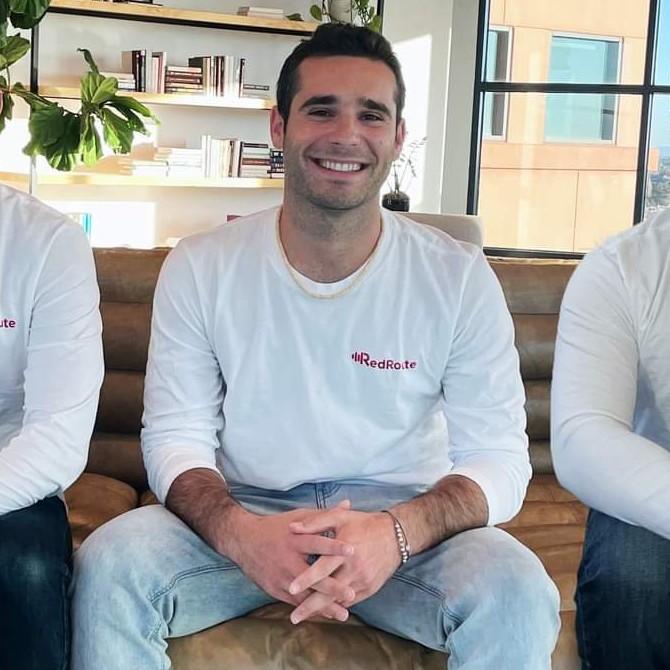
Brian Schiff
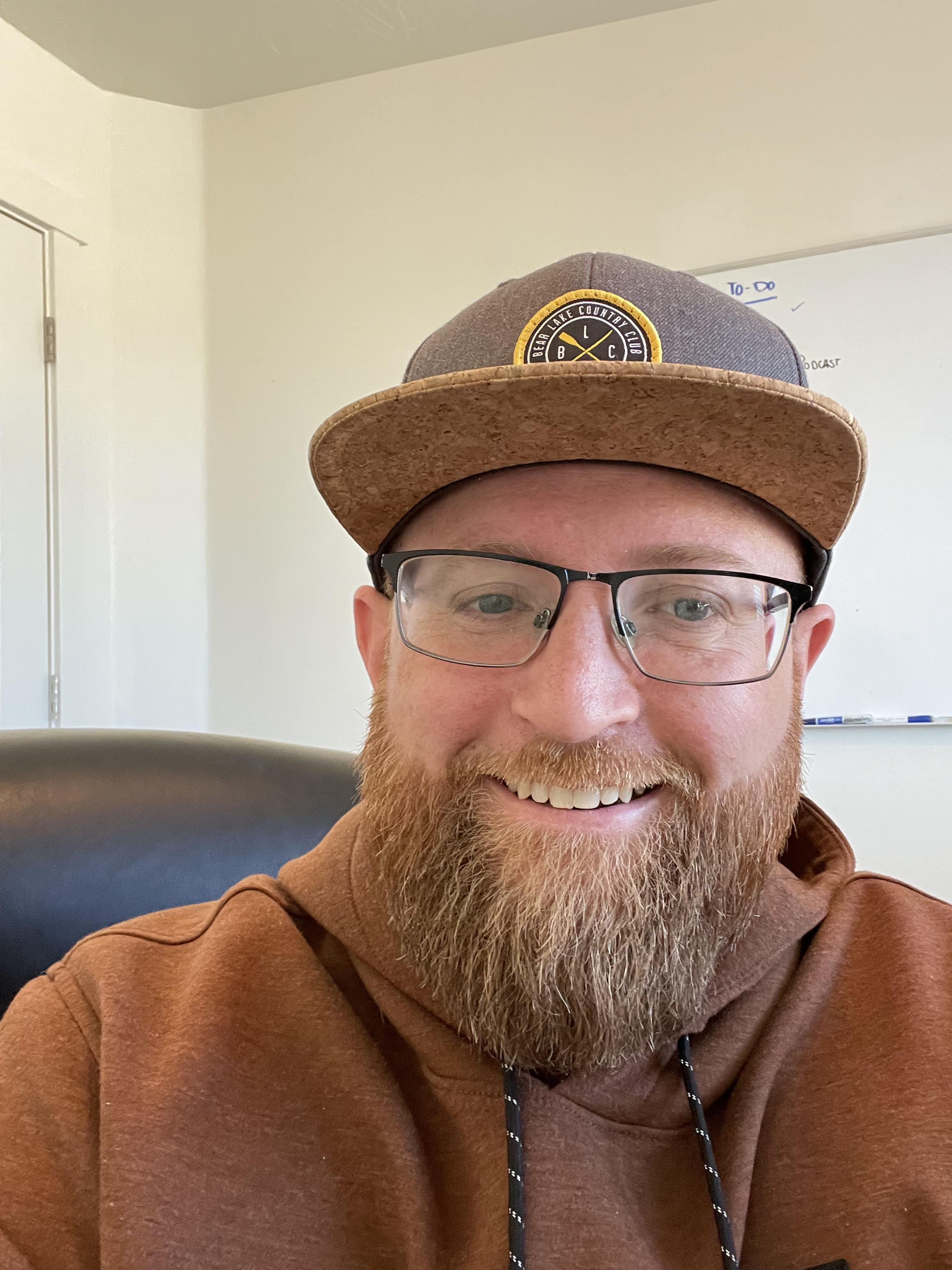
James Gilbert
Today's Guests

